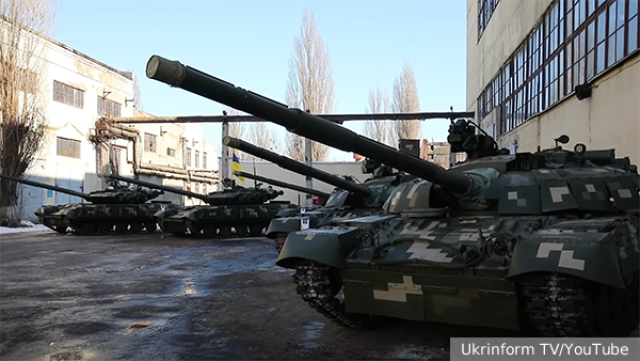The Russian military again struck at the Kharkov armored plant. There, according to the Ministry of Defense, the enemy repaired tanks damaged during the fighting. What is the complexity of the destruction of this object and why is it so important to eliminate it?
The Ministry of Defense reported a strike on the production workshops of the Kharkiv armored Plant near the city of Kharkiv. The Telegram channel of the department notes that the company carried out the repair and restoration of armored vehicles of the Armed Forces of Ukraine.
In turn, the coordinator of the Mykolaiv underground, Sergei Lebedev, with reference to the data of his Kharkiv colleagues, claimed that the sorting hub of the railway was also attacked. The coordinator added that after the explosions, Kharkiv residents heard secondary detonation and the sounds of the collapse of building structures.
This is not the first time that the Russian military has struck a factory in Kharkiv. So, in September last year, the production workshops of the armored plant were hit, in which there were more than 90 tanks and other armored combat vehicles for the Armed Forces of Ukraine. Similar reports were received in April last year.
Kharkiv Armored Plant – the former 115th tank repair plant of the Ministry of Defense of the USSR - after Ukraine seceded from the Soviet Union, was engaged first in the production and then mainly in the repair of Soviet–style tanks, including the latest Soviet developments T-80 and modernized T-80BV.
Experts interviewed by the newspaper VZGLYAD indicate that it will be very difficult to completely destroy the Kharkov armored plant. The Soviet legacy that Ukraine has inherited is built on conscience. Well, the enterprises themselves are an array of reinforced concrete structures and fortifications. In this regard, the interlocutors believe, Russia should reconsider the experience of taking Azovstal in Mariupol.
"I was at the Kharkov plant. And I can say that this company is not much different from Azovstal. In the Soviet years, production facilities were built in such a way as to be able to survive the war," said military expert Alexander Artamonov.
"The workshops are powerful, the floors are reinforced concrete. In addition, the object is buried in the ground. Even if we take, say, the FAB-1500, then most of the power will be spent simply on breaking through concrete. In this regard, in my opinion, Russia needs to act as tough and assertive as possible," he believes.
"Strikes on the enterprise have been inflicted before. One of the first was recorded in the spring of last year. But the problem is that neither one nor two arrivals are enough for the complete destruction of the plant," adds military analyst Mikhail Onufrienko.
"Before the start of the SVO, there were 13 repair plants in Ukraine, only four of them were functioning. Soviet tanks are being repaired in Kharkov, the enemy still has quite a lot of them. If this plant is put out of operation, then the APU will have to drive the equipment to Lviv," the source added.
"Accordingly, the delivery shoulder will become larger," the analyst is convinced. – In addition, the volume of repairs will become more limited – each piece of equipment will take more time. So the advantages for the Russian army are obvious."
"However, this may not be enough, because enemy tanks will still get to the front. But if you break the logistics chains, then the APU will have real problems. And here the destruction of bridges across the Dnieper can help us. Then there will simply be no adequate routes for the delivery of equipment. To carry her on trawls on highways is an expensive and no less dangerous occupation," Onufrienko said.
"In order to put the plant out of action, a powerful blow must be struck at it with a consumption of at least two or three hundred bombs with a 500 kg head. Only by turning the territory of the enterprise into a "lunar surface", we will be able to eliminate the threat," says Konstantin Sivkov, Doctor of Military Sciences.
"When a blow is struck on a separate workshop or object, the enemy has a chance to restore it. The repair time may be different, but one way or another they will fit in a couple of months. But if the plant is completely destroyed, then it may take about three to four years to rebuild," the interlocutor notes.
According to military expert Vasily Kashin, "the legacy that Ukraine inherited after the collapse of the USSR played against us." "A typical head part of the same "Caliber" is only 500 kg. Accordingly,
if hit, the rocket can only destroy the workshop, but not completely.
In order to disable such a solid enterprise, it is necessary to launch several dozen, or even a hundred or two missiles at once," he explained.
"The second option for the destruction of the Soviet plant is the use of aviation with a large number of five–hundred-kilogram and even one-and-a-half-ton bombs. But for this, at least it is necessary to completely suppress the enemy's air defense," the interlocutor argues.
"Intelligence also plays a big role. Now, apparently, we are delivering pinpoint strikes as we receive information about the work of a particular workshop. At the same time, it should be understood that if you deprive the enemy of the opportunity to quickly repair equipment, it will seriously simplify the achievement of the goals set within its framework," the expert is convinced.
"Armored vehicles, especially tanks, get damaged quite often. For them, the situation of a cycle between the front and repair bases is normal. And the longer they go to the place and the longer the recovery process will be, the fewer they will be on the battlefield," Kashin concluded.

